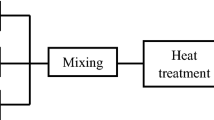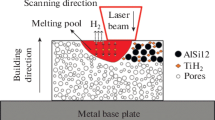Abstract
Titanium hydride attracts more attention as foaming agent in the fabrication of cellular metal materials. In order to meet most aluminum casting alloy’s melting properties, the heat treatment processes for TiH2 particles were investigated in a rotating device. In the present work, the most two important dynamic parameters, the treating temperature and oxidation interval, were taken under consideration. The decomposition behavior of titanium hydride was measured by differential scanning calorimetry (DSC) and the residual hydrogen content, morphologies and phase conversion were also characterized by hydrogen determinator, scanning electron microscopy (SEM), and X-ray diffractometer (XRD), respectively. The results show that the effect of temperature on the formation of oxidation film and decomposition behavior of TiH2 is more significant than that of oxidation time. The onset temperature and peak value of TiH2 decomposition shift from left to right through elevating temperature and extending time. Heat treatment process for TiH2 at 500 °C between 1 and 5 h in air is favorable for preparing aluminum foam.





Similar content being viewed by others
References
Baumgärtner F, Duarte I, Banhart J. Industrialization of powder compact foaming process. Adv Eng Mater. 2000;2(4):168.
Miyoshi T, Itoh M, Akiyama S, Kitahara A. Production process, properties and applications. Adv Eng Mater. 2000;2(4):179.
Yang CC, Nakae H. Foaming characteristics control during production of aluminum alloy foam. J Alloy Compd. 2000;313(1–2):188.
Zeppelin FV, Hirschera M, Stanzickb H, Banhart J. Desorption of hydrogen from blowing agents used for foaming metals. Compos Sci Technol. 2003;63(16):2293.
Helfen L, Baumbach T, Stanzick H, Banhart J, Elmoutaoaukkil A, Cloetens P. Viewing the early stage of metal foam formation by computed tomography using synchrotron radiation. Adv Eng Mater. 2002;4(10):808.
Han FS, Zhu ZG, Gao JC, Song WH. Effect of oxidation treatment and surface filming on hydrogen degassing from TiH2. Metall Mater Trans B. 1998;29(6):1315.
Nakamura T, Gnyloskurenko SV, Sakamoto K, Byakova AV, Ishik-awa R. Development of new foaming agent for metal foam. Mater Trans. 2002;43(5):1191.
Chen WD, Yan SF, Yan GQ, Zhang YZ. Influence of oxidizing atmosphere on hydrogen permeation barriers of zirconium hydride. Chin J Rare Met. 2013;37(3):418.
Yan GQ, Chen WD, Zhong XK, Yan SF. Properties of oxide coating on the surface of ZrH1.8 prepared by microarc oxidation with different positive voltages. Rare Met. 2013;32(2):169.
Kennedy AR. The effect of TiH2 heat treatment on gas release and foaming in Al–TiH2 preforms. Scr Mater. 2002;47(11):763.
Matijasevic B, Banhart J. Improvement of aluminium foam technology by tailoring of blowing agent. Scr Mater. 2006;54(4):503.
Jimenez C, Garcia-Moreno F, Pfretzschner B, Klaus M, Wollgarten M, Zizak I, Schumacher G, Tovar M, Banhart J. Decomposition of TiH2 studied in situ by synchrotron X-ray and neutron diffraction. Acta Mater. 2011;59(16):6318.
Mandrino D, Paulin I, Skapin SD. Scanning electron microscopy, X-ray diffraction and thermal analysis study of the TiH2 foaming agent. Mater Chem. 2012;72:87.
Paulin I, Donik C, Mandrino D, Voncina M, Jenko M. Surface characterization of titanium hydride powder. Vacuum. 2012;86(6):608.
Matijasevic-Lux B, Banhart J, Fiechter S, Gorke O, Wanderka N. Modification of titanium hydride for improved aluminium foam manufacture. Acta Mater. 2006;54(7):1887.
Kennedy AR, Lopez VH. The decomposition behavior of as-received and oxidized TiH2 foaming-agent powder. Mater Sci Eng A. 2003;357(1–2):258.
Gergely V, Clyne B. The FORMGRIP process: foaming of reinforced metals by gas release in precursors. Adv Eng Mater. 2000;2(4):175.
Acknowledgments
This study was financially supported by the National Natural Science Foundation of China (No. 51174060) and the Science and Technology Department of Liaoning Province of China (No. 2013223004).
Author information
Authors and Affiliations
Corresponding author
Rights and permissions
About this article
Cite this article
Luo, HJ., Lin, H., Chen, PH. et al. Decomposition behavior of titanium hydride treated by surface oxidation. Rare Met. 34, 28–33 (2015). https://doi.org/10.1007/s12598-014-0415-z
Received:
Revised:
Accepted:
Published:
Issue Date:
DOI: https://doi.org/10.1007/s12598-014-0415-z




